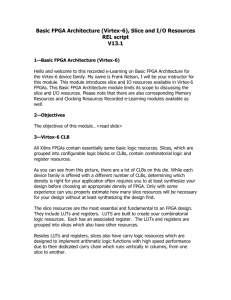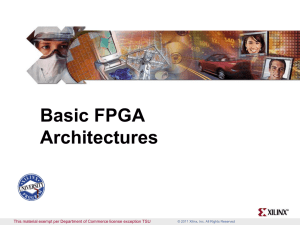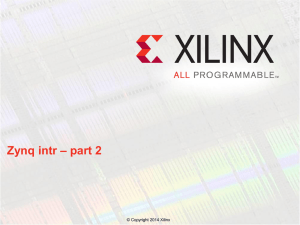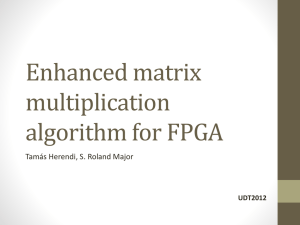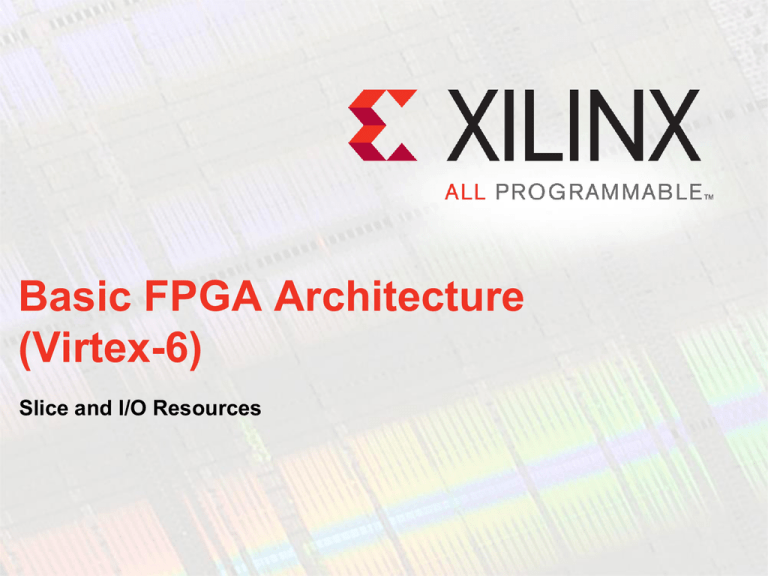
Basic FPGA Architecture
(Virtex-6)
Slice and I/O Resources
Objectives
After completing this module, you will be able to:
Describe the CLB and slice resources available in Virtex-6
FPGAs
Describe flip-flop functionality
Anticipate building proper HDL code for Virtex-6 FPGAs
Virtex-6 CLB
COUT
COUT
CIN
CIN
CLB contains two slices
– Connected to a switch
matrix for routing to
Carry chain runs
vertically in a column
Switch
Matrix
other FPGA resources
from one slice to the one
above
– The Virtex-6 FPGA has a separate carry chain
for each slice
Routing
The Virtex-6 FPGAs use a diagonally symmetric
interconnect pattern
– A rich set of programmable interconnections exist
between one switch matrix and the switch matrices
nearby
– Many CLBs can be reached with only a few “hops”
• A hop is a connection through an active connection point
The mapping of logical connections to these
physical routing resources is entirely managed
by the router (PAR)
– The place and route solution is directed by your use
timing constraints (very important)
With the exception of the carry chain, all slice
connections are done through the switch matrix
CLB
Direct
1 Hop
2 Hops
3 Hops
6-Input LUT with Dual Output
6-input LUT with 1 output or…
…it can be two 5-input LUTs (using common inputs) with 2 outputs
– Minimal speed impact for either
configuration
– One or two outputs
– Any function of six variables or
two independent functions of
five variables
FPGA Slice Resources
Four six-input Look Up Tables (LUT)
Four additional flip-flops
– These are the new flip-flops
Four flip-flop/latches
LUT/RAM/SRL
Carry chain
– This is supported on four of the eight
flip-flops
LUT/RAM/SRL
Wide multiplexers
– The implementation tools (MAP)
will choose the packing of the design
LUT/RAM/SRL
LUT/RAM/SRL
01
Wide Multiplexers
Each F7MUX combines the
outputs of two LUTs together
– Can implement an arbitrary 7-input
function
LUT/RAM/SRL
– Can implement an 8-1 multiplexer
The F8MUX combines the
outputs of the two F7MUXes
LUT/RAM/SRL
– Can implement an arbitrary 8-input
function
– Can implement a 16-1 multiplexer
MUX output can drive or bypass
the flip-flop/latch
– MUX is controlled by the BX/CX/DX
slice input
LUT/RAM/SRL
LUT/RAM/SRL
01
Carry Logic
Carry logic can implement fast
arithmetic addition and
subtraction
– Carry out is propagated vertically
through the four LUTs in a slice
– The carry logic propagates from one
slice to the next CLB above
LUT/RAM/SRL
LUT/RAM/SRL
Requires bit ordering
Carry look-ahead
– Combinatorial carry look-ahead over
the four LUTs in a slice
– Implements faster carry cascading
from slice to slice
LUT/RAM/SRL
LUT/RAM/SRL
01
Flip-Flops and Latches
Each slice has four flip-flop/latches
(FF/L)
FF
FF/L
– Can be configured as either flip-flops or
latches
– The D input can come from the O6 LUT
output, the carry chain, the wide
multiplexer, or the AX/BX/CX/DX slice
input
Each slice also has four flip-flops
(FF)
LUT/RAM/SRL
LUT/RAM/SRL
– D input can come from O5 output or the
AX/BX/CX/DX input
• These don’t have access to the carry
chain, wide multiplexers, or the slice inputs
If any of the FF/L are configured as
latches, the four FFs are not
available
LUT/RAM/SRL
LUT/RAM/SRL
01
CLB Control Signals
D
CE
– This is referred to as the “control set” of the flip-flops
– CE and SR are active high
– CLK can be inverted at the slice boundary
– All four flip-flop/latches are configured the same
– All four flip-flops are configured the same
– SR will cause the flip-flop to be set to the state
specified by the SRVAL attribute
– FFs in the Virtex-6 FPGA have an additional INITVAL
CK
D Q
CE
CE
CK
CK
SR
SRSR
●●●
Set/Reset (SR) signal can be configured as
synchronous or asynchronous
Q
AFF/LATCH
DFF
D
Q
CE
CK
SR
●●●
All flip-flops and flip-flop/latches share the same
CLK, SR, and CE signals
AFF
DFF/LATCH
D
Q
CE
CK
SR
SLICEM as Distributed RAM
Single
Port
32x2
32x4
32x6
32x8
64x1
64x2
64x3
64x4
128x1
128x2
256x1
Dual
Port
32x2D
32x4D
64x1D
64x2D
128x1D
Simple
Dual Port
32x6SDP
64x3SDP
Quad
Port
32x2Q
64x1Q
Uses the same storage that is used
for the look-up table function
Synchronous write, asynchronous
read
– Can be converted to synchronous read
using the flip-flops available in the slice
Various configurations
– Single port
• One LUT6 = 64x1 or 32x2 RAM
• Cascadable up to 256x1 RAM
– Dual port (D)
• 1 read / write port + 1 read-only port
Each port has independent
address inputs
– Simple dual port (SDP)
• 1 write-only port + 1 read-only port
– Quad-port (Q)
• 1 read / write port + 3 read-only ports
SLICEM as 32-bit Shift Register
Versatile SRL-type shift registers
– Variable-length shift register
– Synchronous FIFOs
– Content-Addressable Memory
(CAM)
– Pattern generator
– Compensate for delay / latency
– Shift register length is determined
by the address
LUT
D
CLK
32-bit Shift register
32
A
5
MUX
• Constant value giving fixed delay line
Qn
• Dynamic addressing for elastic buffer
Cascadable up to 128x1 shift
register in one slice
SRL Configurations
in one Slice (4 LUTs)
16x1, 16x2, 16x4, 16x6, 16x8
32x1, 32x2, 32x3, 32x4
64x1, 64x2
SRL is not loadable, has no
reset, and only supports serial
in/serial out
Q 31
96x1
128x1
Shift Register LUT Example
20 Cycles
64
Operation A
Operation B
8 Cycles
12 Cycles
Operation C
Operation D - NOP
3 Cycles
17 Cycles
64
Paths are Statically
Balanced
20 Cycles
Operation D - NOP must add 17 pipeline stages of 64 bits each
– 1,088 flip-flops (136 slices) or
– 64 SRLs (16 slices)
Two Types of Slices
Virtex-6 FPGA
Two types of slices
– SLICEM: Full slice (25%)
• LUT can be used for logic and
memory/SRL
• Has wide multiplexers and carry chain
– SLICEL: Logic and arithmetic only (75%)
• LUT can only be used for logic
(not memory)
• Has wide multiplexers and carry chain
SLICEL
SLICEL
or
SLICEM
SLICEL
I/O Bank Structure
I/Os are grouped into banks
– All I/O banks are in columns
– 9 – 30 I/O banks, depending on chip type
• 40 I/Os per bank
– More I/O banks allows greater mixture of
standards across
the chip
– Clocking resources specific to each bank
• Global and/or regional clocking resources
BANK
BANK
BANK
BANK
BANK
BANK
– Based on common VCCO, VREF
BANK
– This is called the I/O banking rules
BANK
Voltage translation only allows compatible
I/O standards in one bank (share common
power supply)
BANK
Virtex-6 FPGA
– Used to clock data in and clock data out of the
device
I/O Versatility
Each I/O supports 40+ voltage and protocol standards, including
– LVCMOS
– LVDS, Bus LVDS
– LVPECL
– SSTL
– HSTL
– RSDS_25 (point-to-point)
– Based on banking rules (some standards not compatible within the same
bank)
Each pin can be input and output (including 3-state)
Each pin can be individually configured
– IODELAY, drive strength, input threshold, termination, weak pull-up or pulldown
I/O Electrical Resources
P and N pins can be configured as
singleended…or differential pair
• This example shows a differential pair that is
coupling two neighboring (and pre-assigned)
pins
Tx
P
Rx
• Receiver available in all banks
• Receiver termination available in all banks
LVDS
Termination
Tx
N
Rx
IOB Element
Input path
– Two DDR registers
Output path
– Two DDR registers
– Two 3-state enable
DDR registers
Separate clocks and
clock enables for input and
output
Set and reset signals
are shared
I/O Logical Resources
– Master and slave
– Can operate independently or
concatenated
Each IOLOGIC contains…
– IOSERDES
• Parallel to serial converter (serializer)
• Serial to parallel converter
(De-serializer)
– IODELAY
• Selectable fine-grained delay
– SDR and DDR resources
Interconnect to FPGA fabric
Two IOLOGIC blocks per I/O pair
Master IOLOGIC
IOSERDES
IODELAY
Slave
IOLOGIC
IOSERDES
IODELAY
Flip-Flop Details
All eight flip-flops share the same control signals
FF
– CK – clock
– CE – Clock Enable
– SR – Set/Reset
Each flip-flop has four input signals
– D – data input
– CK – clock
– CE – clock enable (Active High)
– SR – async/sync set/reset (Active High)
• Either Set or Reset can be implemented (not both)
D
CE
CK
Q
SR
Design Tips
Suggestions for faster and smaller designs
– Design synchronously
• Use a synchronous Set/Reset whenever possible
FF1
D
CE
CK
• Don’t gate your clock (use the CE)
SR
• Manage your clocks skew (use global or regional clock
routing resources
●●●
– Leverage FPGA Global Reset whenever possible
• Requires instantiation of the Startup component
• Save routing resources
– Use active-high CE and Set/Reset (no local inverter)
Q
FF8
D
CE
CK
Q
SR
Software
Software intelligently packs logic
Design
FPGA
Slice
LUT
LUT
LUT
LUT
Related logic and flip-flops are coded
Software places the logic and flip-flop in the same
slice
Software packs logic for optimum performance
Control Signals
Different flip-flop configurations
– If coded registers do not map cleanly to the flip-flops, the software tools
will automatically implement the missing functionality by using additional
slice resources
– Can increase overall LUT utilization
Case
CE active Low
Design
D
CE
CK
Q
FPGA
D
CE
Q
D
CK
Both Synchronous Set and
Reset are used
D
CK
Q
Sset
SReset
D
D
Sset
SReset
Software uses logic to map extra control functions
SR
CK
Q
Control Set Reduction
Flip-flops with different control sets cannot be packed into the
same slice
Software can be instructed to reduce the number of control sets
by mapping control logic to LUT resources
– This results in higher LUT utilization, but a lower overall slice utilization
Design
FPGA
Q
D
3 Slices
CK
CK
D
Q
CK
Sset
D
Q
D
Sset
D
CK
Q
D
SReset
D
CK
Q
Q
CK
SReset
1 Slice
D
Using the Slice Resources
Three primary mechanisms for using FPGA resources
– Inference
• Describe the behavior of the desired circuit using Register Transfer Language
(RTL)
• The synthesis tool will analyze the described behavior and use the required
FPGA resources to implement the equivalent circuit
– Instantiation
• Create an instance of the FPGA resource using the name of the primitive and
manually connecting the ports and setting the attributes
– CORE Generator™ tool and Architecture Wizard
• The CORE Generator software and Architecture Wizard are graphical tools that
allow you to build and customize modules with specific functionality
• The resulting modules range from simple modules containing few FPGA
resources or highly complex Intellectual Property (IP) cores
Inference
All primary slice resources can be inferred by XST and Synplify
– LUTs
• Most combinatorial functions will map to LUTs
– Flip-flops
• Coding style defines the behavior
– SRL
• Non-loadable, serial functionality
– Multiplexers
• Use a CASE statement or other conditional operators
– Carry logic
• Use arithmetic operators (addition, subtraction, comparison)
Inference should be used wherever possible
– HDL code is portable, compact, and easily understood and maintained
Instantiation
For a list of primitives that can be instantiated, see the HDL
library guide
– Provides a list of primitives, their functionality, ports, and attributes
Use instantiation when it is difficult to infer the exact resource
you want
Help Software
Manuals
Libraries Guides
Architecture Wizard
The CORE Generator tool and Architecture Wizard can help you
create modules with the required functionality
– Typically used for FPGA-specific resources (like clocking, memory, or I/O),
or for more complex functions (like memory controllers or DSP functions)
Summary
All slices contain four 6-input LUTs and eight registers
– LUTs can perform any combinatorial function of up to six inputs or two
functions of five inputs
– Four of the eight registers can be used as flip-flops or latches; the
remaining four can only be used as flip-flops
– Flip-flops have active high CE inputs and active high synchronous or
asynchronous Set/Rest inputs
SLICEL slices also contain carry logic and the dedicated multiplexers
– The MUXF7 multiplexers combine LUT outputs to create 8-input
multiplexers
– The MUXF8 multiplexers combine the MUXF7 outputs to create 16-input
multiplexers
– The carry logic can be used to implement fast arithmetic functions
The LUTs in SLICEM slices can also SRL and distributed memory
functionality
Manage your control set usage to reduce the size and increase the
speed of your design
Where Can I Learn More?
Software Manuals
– Start Xilinx ISE Design Suite 13.1 ISE Design Tools
Documentation Software Manuals
– This includes the Synthesis & Simulation Design Guide
• This guide has example inferences of many architectural resources
– XST User Guide
• HDL language constructs and coding recommendations
– Targeting and Retargeting Guide for Virtex-6 FPGAs, WP309
– Virtex-6 FPGA User Guides
Xilinx Education Services courses
– www.xilinx.com/training
• Xilinx tools and architecture courses
• Hardware description language courses
• Basic FPGA architecture, Basic HDL Coding Techniques, and other Free
Videos!
Trademark Information
Xilinx is disclosing this Document and Intellectual Property (hereinafter “the Design”) to you for use in the development of designs to operate on,
or interface with Xilinx FPGAs. Except as stated herein, none of the Design may be copied, reproduced, distributed, republished, downloaded,
displayed, posted, or transmitted in any form or by any means including, but not limited to, electronic, mechanical, photocopying, recording, or
otherwise, without the prior written consent of Xilinx. Any unauthorized use of the Design may violate copyright laws, trademark laws, the laws of
privacy and publicity, and communications regulations and statutes.
Xilinx does not assume any liability arising out of the application or use of the Design; nor does Xilinx convey any license under its patents,
copyrights, or any rights of others. You are responsible for obtaining any rights you may require for your use or implementation of the Design.
Xilinx reserves the right to make changes, at any time, to the Design as deemed desirable in the sole discretion of Xilinx. Xilinx assumes no
obligation to correct any errors contained herein or to advise you of any correction if such be made. Xilinx will not assume any liability for the
accuracy or correctness of any engineering or technical support or assistance provided to you in connection with the Design.
THE DESIGN IS PROVIDED “AS IS" WITH ALL FAULTS, AND THE ENTIRE RISK AS TO ITS FUNCTION AND IMPLEMENTATION IS WITH
YOU. YOU ACKNOWLEDGE AND AGREE THAT YOU HAVE NOT RELIED ON ANY ORAL OR WRITTEN INFORMATION OR ADVICE,
WHETHER GIVEN BY XILINX, OR ITS AGENTS OR EMPLOYEES. XILINX MAKES NO OTHER WARRANTIES, WHETHER EXPRESS,
IMPLIED, OR STATUTORY, REGARDING THE DESIGN, INCLUDING ANY WARRANTIES OF MERCHANTABILITY, FITNESS FOR A
PARTICULAR PURPOSE, TITLE, AND NONINFRINGEMENT OF THIRD-PARTY RIGHTS.
IN NO EVENT WILL XILINX BE LIABLE FOR ANY CONSEQUENTIAL, INDIRECT, EXEMPLARY, SPECIAL, OR INCIDENTAL DAMAGES,
INCLUDING ANY LOST DATA AND LOST PROFITS, ARISING FROM OR RELATING TO YOUR USE OF THE DESIGN, EVEN IF YOU HAVE
BEEN ADVISED OF THE POSSIBILITY OF SUCH DAMAGES. THE TOTAL CUMULATIVE LIABILITY OF XILINX IN CONNECTION WITH
YOUR USE OF THE DESIGN, WHETHER IN CONTRACT OR TORT OR OTHERWISE, WILL IN NO EVENT EXCEED THE AMOUNT OF
FEES PAID BY YOU TO XILINX HEREUNDER FOR USE OF THE DESIGN. YOU ACKNOWLEDGE THAT THE FEES, IF ANY, REFLECT
THE ALLOCATION OF RISK SET FORTH IN THIS AGREEMENT AND THAT XILINX WOULD NOT MAKE AVAILABLE THE DESIGN TO YOU
WITHOUT THESE LIMITATIONS OF LIABILITY.
The Design is not designed or intended for use in the development of on-line control equipment in hazardous environments requiring fail-safe
controls, such as in the operation of nuclear facilities, aircraft navigation or communications systems, air traffic control, life support, or weapons
systems (“High-Risk Applications”). Xilinx specifically disclaims any express or implied warranties of fitness for such High-Risk Applications. You
represent that use of the Design in such High-Risk Applications is fully at your risk.
© 2012 Xilinx, Inc. All rights reserved. XILINX, the Xilinx logo, and other designated brands included herein are trademarks of Xilinx, Inc. All
other trademarks are the property of their respective owners.

